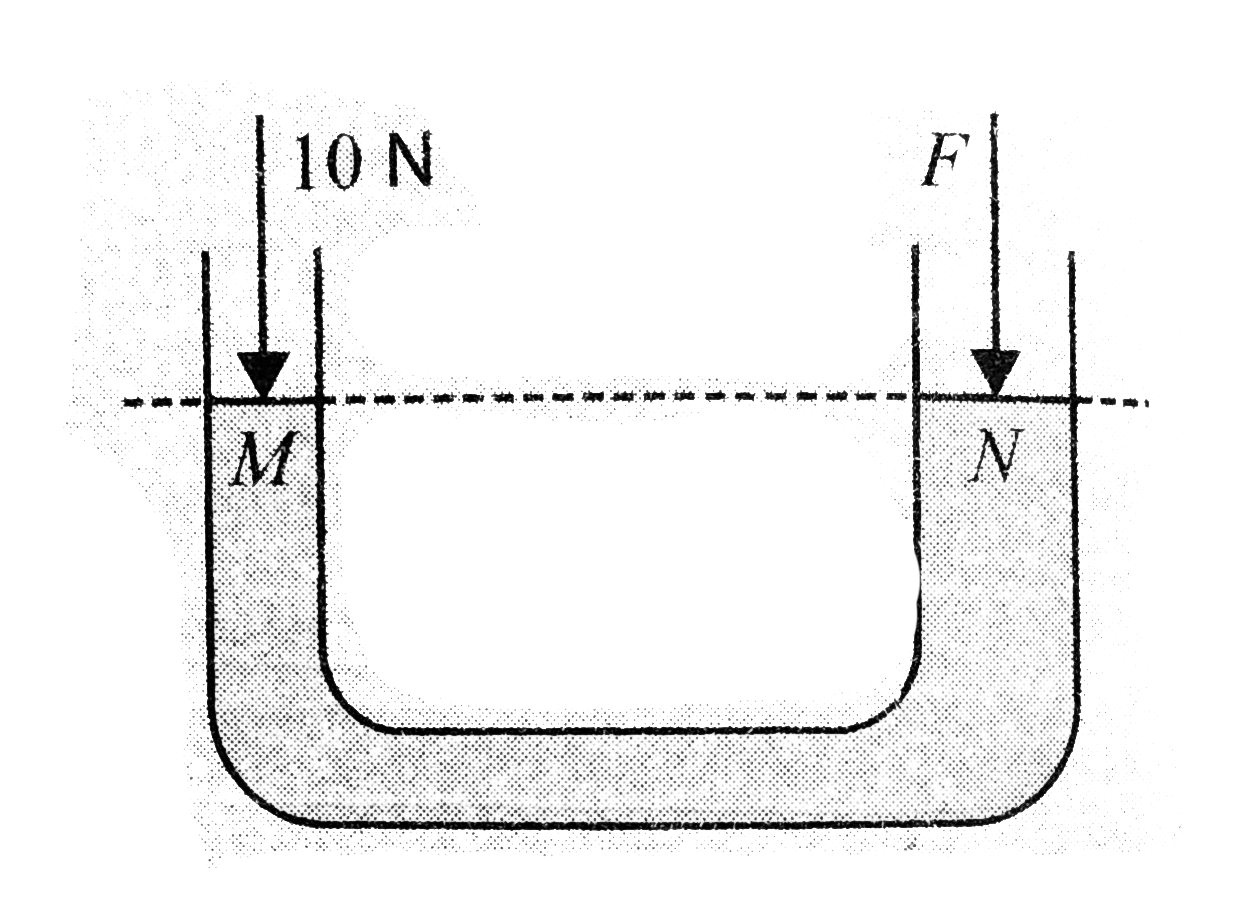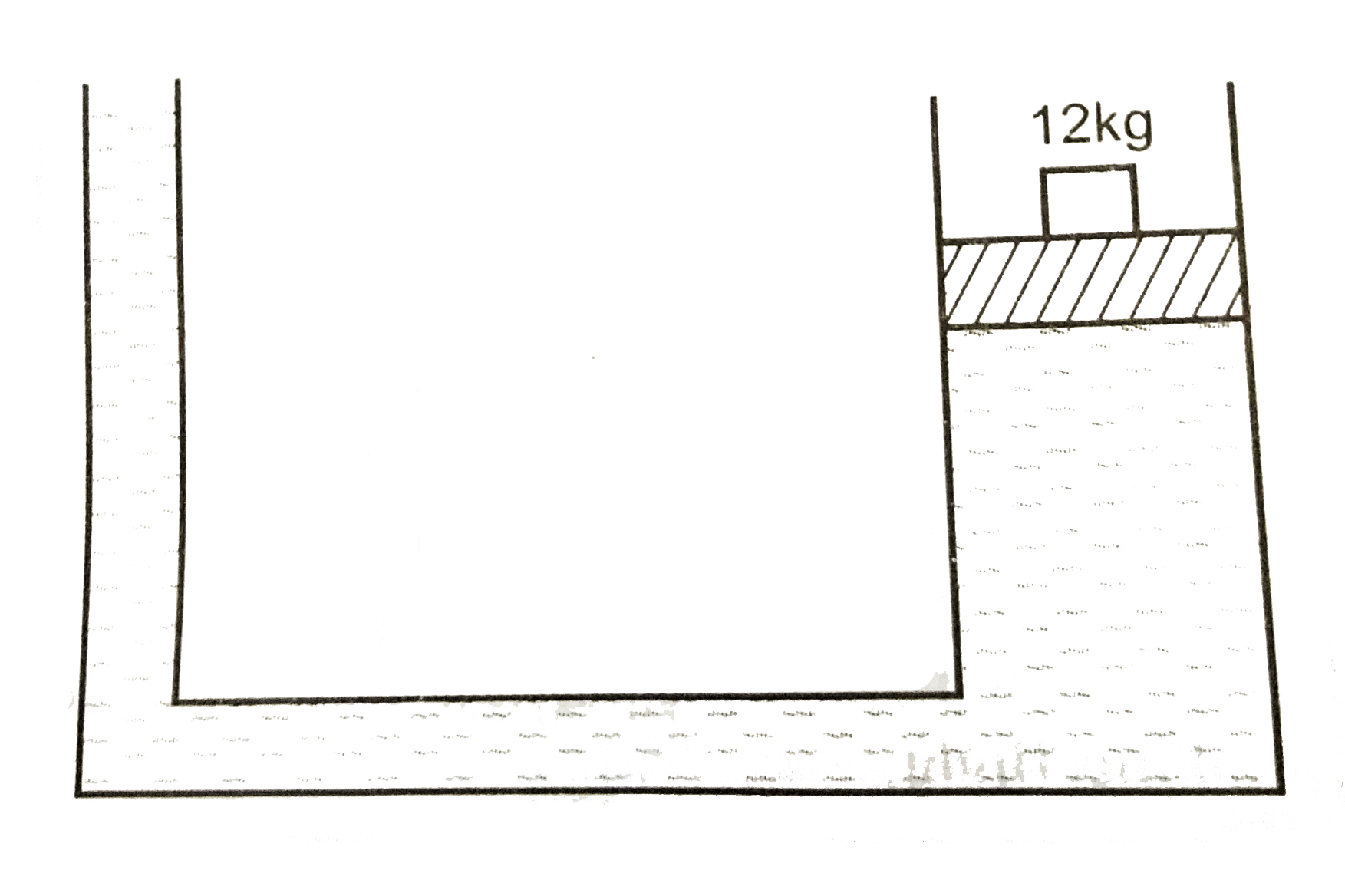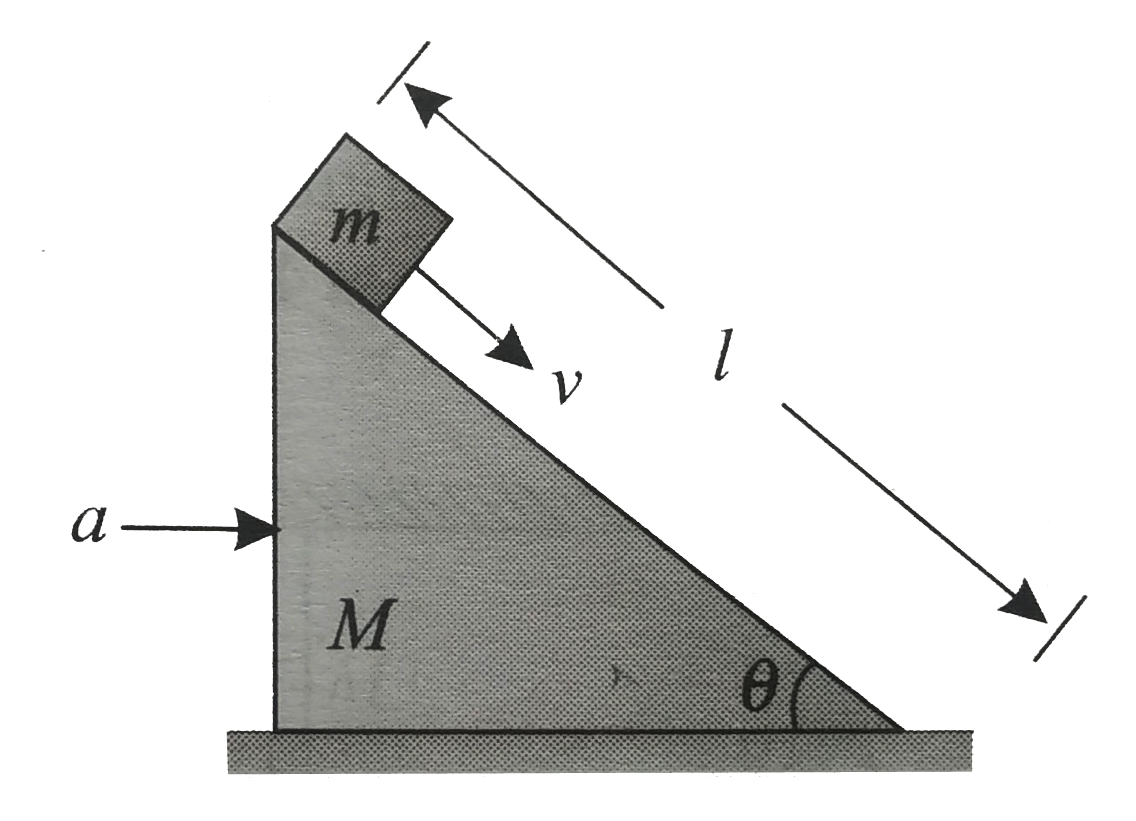Two syringes of different cross-section (without needle filled with water are connected with a tightly fitted rubber tube filled with water. Diameters of the smaller piston an larger piston are 1cm and 3cm respectively. If a force of 10N is applied to the smaller piston then the force exerted on the larger piston is
30N
60 N
90 N
100 N
The correct Answer is:C
To solve the problem of finding the force exerted on the larger piston when a force is applied to the smaller piston, we can use the principle of Pascal's law, which states that pressure applied to a confined fluid is transmitted undiminished throughout the fluid.
1. Identify the Given Values:
- Diameter of the smaller piston, d1=1cm=0.01m
- Diameter of the larger piston, d2=3cm=0.03m
- Force applied to the smaller piston, F1=10N
2. Calculate the Radii of the Pistons:
- Radius of the smaller piston, r1=d12=0.012=0.005m
- Radius of the larger piston, r2=d22=0.032=0.015m
3. Calculate the Areas of the Pistons:
- Area of the smaller piston, A1=πr21=π(0.005)2=π×0.000025≈7.85×10−5m2
- Area of the larger piston, A2=πr22=π(0.015)2=π×0.000225≈7.07×10−4m2
4. Apply Pascal's Law:
- According to Pascal's law, the pressure exerted on the smaller piston is equal to the pressure exerted on the larger piston:
F1A1=F2A2
Rearranging gives:
F2=F1⋅A2A1
5. Substituting the Values:
- Substitute F1=10N, A1, and A2:
F2=10⋅7.07×10−47.85×10−5
- Calculate the ratio:
A2A1=7.07×10−47.85×10−5≈9
- Therefore:
F2=10⋅9=90N
6. Conclusion:
- The force exerted on the larger piston is F2=90N.
- Diameter of the smaller piston, d1=1cm=0.01m
- Diameter of the larger piston, d2=3cm=0.03m
- Force applied to the smaller piston, F1=10N
- Radius of the smaller piston, r1=d12=0.012=0.005m
- Radius of the larger piston, r2=d22=0.032=0.015m
- Area of the smaller piston, A1=πr21=π(0.005)2=π×0.000025≈7.85×10−5m2
- Area of the larger piston, A2=πr22=π(0.015)2=π×0.000225≈7.07×10−4m2
- According to Pascal's law, the pressure exerted on the smaller piston is equal to the pressure exerted on the larger piston:
F1A1=F2A2
Rearranging gives:
F2=F1⋅A2A1
- Substitute F1=10N, A1, and A2:
F2=10⋅7.07×10−47.85×10−5
- Calculate the ratio:
A2A1=7.07×10−47.85×10−5≈9
- Therefore:
F2=10⋅9=90N
- The force exerted on the larger piston is F2=90N.
Topper's Solved these Questions
- BOOK - NCERT FINGERTPS ENGLISHCHAPTER - MECHANICAL PROPERTIES OF FLUIDSEXERCISE - Higher Order Thinking Skills8videos
MECHANICAL PROPERTIES OF FLUIDS
- BOOK - NCERT FINGERTPS ENGLISHCHAPTER - MECHANICAL PROPERTIES OF FLUIDSEXERCISE - Exemplar Problems5videos
MECHANICAL PROPERTIES OF FLUIDS
- BOOK - NCERT FINGERTPS ENGLISHCHAPTER - LAWS OF MOTIONEXERCISE - Assertion And Reason15videos
LAWS OF MOTION
- BOOK - NCERT FINGERTPS ENGLISHCHAPTER - MECHANICAL PROPERTIES OF SOLIDSEXERCISE - Assertion And Reason15videos
MECHANICAL PROPERTIES OF SOLIDS
Similar Questions
Two syringes of different cross-sections (without needles) filled with water are connected with a tightly fitted rubber tube filled with water. Diameters of the smaller piston and larger piston are 1.0cm and 3.0 cm respectively.
(a) Find the force on the larger piston when a force of 10N is applied to the smaller piston.
(b) The smaller piston is paused in through 6.0 cm, much does the larger piston move out?View SolutionIn an arrangement similar to a hydraulic lift, the diameters of smaller and larger pistons are 1.0 cm and 3.0 cm respectively. What is the force exerted on the larger piston when a force of 10 N is applied to the smaller piston?
View SolutionThe pressure exerted on the smaller and the larger piston of a hydraulic machine is 15 Pa Calculate the force exerted by it on the larger piston, if the area of cross section of the larger piston is 4m2.
View SolutionThe area of cross sectioin of the two arms of a hydraulic press is 1cm2 and 20cm2 respectively. A force of 10N is applied on the water in the thinner arm. What force should be applid on the water in the thicker arms so that water may remain in equilibrium?
 View Solution
View SolutionThe area of cross section of the two arms of a hydraulilc press are 1 cm^2 and 10 cm^2 respectively figure. A force of 5N is applied on the water in the thinner arm. What force should be applied on the water in the thicker arm so that the water may remain in equilibrium?
 ,View Solution
,View SolutionThe area of cross section of the two arms of a hydraulilc press are 1 cm^2 and 10 cm^2 respectively figure. A force of 5N is applied on the water in the thinner arm. What force should be applied on the water in the thicker arm so that the water may remain in equilibrium?
 ,View Solution
,View SolutionWater is flowing through two horizontal pipes of different diameters which are connected together. The diameters of the two pipes are 3 cm and 6 cm respectively. If the speed of water in the narrower tube is 4ms−1. Then the speed of water in the wider tube is
View SolutionA force of 50 kgf is applied to the smaller piston of a hydraulic machine. Neglecting friction, find the force exerted on the large piston, if the diameters of the pistons are 5 cm and 25 cm respectively.
View SolutionThe area of cross-section of the wider tube shown in fig., is 800cm2 . If a mass of 12 kg is placed on the massless piston, what is the difference in the level of water in two tubes.
 View Solution
View Solution
A smooth wedge of mass M is pushed with an acceleration a=>anθ and a block of mass m is projected down the slant with a velocity v relative to the wedge.
The horizontal force applied on the wedge is:View Solution

